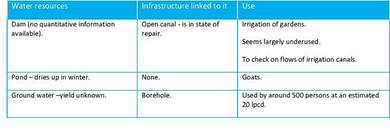Tool 10
TOOL 10. VILLAGE WATER RESOURCES ASSESSMENT
To develop a structured overview of quantitative and qualitative information on available water resources and water infrastructure, and its current and potential future use.
The village water resources assessment is a method through which the, often limited, quantitative information is put together alongside qualitative information. It uses a simplified version of the RIDA framework (see Tool 9). It is an activity undertaken by the facilitator alone, thereby drawing upon the results of participatory exercises done in the community mapping and village walk, and additional information from key informants. Where needed, additional secondary data may be obtained from other agencies.
OBJECTIVE
To develop a structured overview of quantitative and qualitative information on available water resources and water infrastructure, and its current and potential future use.
METHOD
The method consists of the following steps:
Step 1: Draw a table with the main water resources identified in the previous participatory exercises. Add as much quantitative and qualitative information on these resources as available.
Step 2: Add two columns identifying the infrastructure linked to the water resource and the main uses of these water resources. Also include all available quantitative and qualitative information on both infrastructure and water use. Add untapped resources and potential infrastructure. See Table 9 below.
Table 9 - Example of village water resource table

Source: ZIMWASH, 2010
Step 3: Compile information from secondary sources when back in the office for each of the cells, where available.
Step 4: Carry out a desk-top analysis, focusing on questions such as:
- Which (potential and current) uses are insufficiently met?
- What is the overall infrastructure status to meet the identified water uses and needs? Is there scope or need to develop additional infrastructure?
- What is the status of existing water resources? What are potential untapped resources?
BASED ON
Tool 6 in: ZIMWASH, 2010. Guidelines for Planning for Water for Livelihoods, Harare: ZIMWASH Project.
